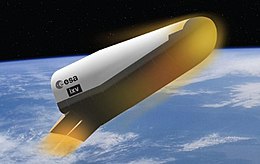 Artist's view of IXV reentry phase | |
| Mission type | technology demonstration |
|---|---|
| Operator | ESA |
| Website | ESA Reentry technologies |
| Apogee | 412 km (256 mi) |
| Spacecraft properties | |
| Spacecraft type | lifting body |
| Manufacturer | Thales Alenia Space |
| Launch mass | 1,800 kg (4,000 lb) |
| Start of mission | |
| Launch date | 13:40, 11 February 2015 (UTC)[1][2][3] |
| Rocket | Vega |
| Launch site | Guiana Space Centre ELV |
| End of mission | |
| Landing date | 11 February 2015 |
| Landing site | Pacific Ocean |
Programme for Reusable In-orbit Demonstrator in Europe (PRIDE program) | |
The Intermediate eXperimental Vehicle (IXV) is a European Space Agency (ESA) experimental suborbital re-entry vehicle. It was developed to serve as a prototype lifting body orbital return vehicle to validate the ESA's work in the field of reusable orbital return vehicles.
The European Space Agency has a program called Future Launchers Preparatory Programme (FLPP), which made a call for submissions for a reusable spaceplane.[4][5] One of the submissions was by the Italian Space Agency, that presented their own Programme for Reusable In-orbit Demonstrator in Europe (PRIDE program) which went ahead to develop an initial test vehicle, Pre-X, followed the prototype named Intermediate eXperimental Vehicle (IXV) and the consequential Space Rider that inherits technology from its prototype IXV.[6]
On 11 February 2015, the IXV conducted its first 100-minute suborbital space flight, successfully completing its mission upon landing intact on the surface of the Pacific Ocean.[7][8] The vehicle is the first ever lifting body to perform full atmospheric reentry from orbital speed.[9]: 23 Past missions have flight tested either winged bodies, which are highly controllable but also very complex and costly, or capsules, which are difficult to control but offer less complexity and lower cost.[10]
- ^ "European space plane set for February launch". News.com.au. News Corp Australia. 22 November 2014. Archived from the original on 14 September 2015. Retrieved 26 November 2014.
- ^ "European space plane set for February launch: firm". 21 November 2014.
- ^ "Worldwide launch schedule". 18 November 2014. Archived from the original on 30 May 2010.
- ^ "New milestone in IXV development". ESA. 15 September 2010.
The Intermediate eXperimental Vehicle (IXV), under ESA's Future Launchers Preparatory Programme (FLPP), is the step forward from the successful Atmospheric Reentry Demonstrator flight in 1998, establishing Europe's role in this field.
- ^ New milestone in IXV development. ESA. 15 September 2010.
- ^ Space Rider PRIDE. Italian Aerospace Research Centre. Accessed: 15 November 2018.
- ^ "IXV Mission Timeline". ESA. 9 February 2015.
It will navigate through the atmosphere within its reentry corridor before descending, slowed by a multistage parachute, for a safe splashdown in the Pacific Ocean some 100 minutes after liftoff.
- ^ "ESA experimental spaceplane completes research flight". ESA. 11 February 2015.
ESA's Intermediate eXperimental Vehicle flew a flawless reentry and splashed down in the Pacific Ocean just west of the Galapagos islands.
- ^ "ESA Bulletin 161 (1st quarter 2015)". Esro / Bulletin Cers/Cecles. ESA. 2015. ISSN 0376-4265.
- ^ "Frequently asked questions on IXV". ESA. Retrieved 28 November 2018.